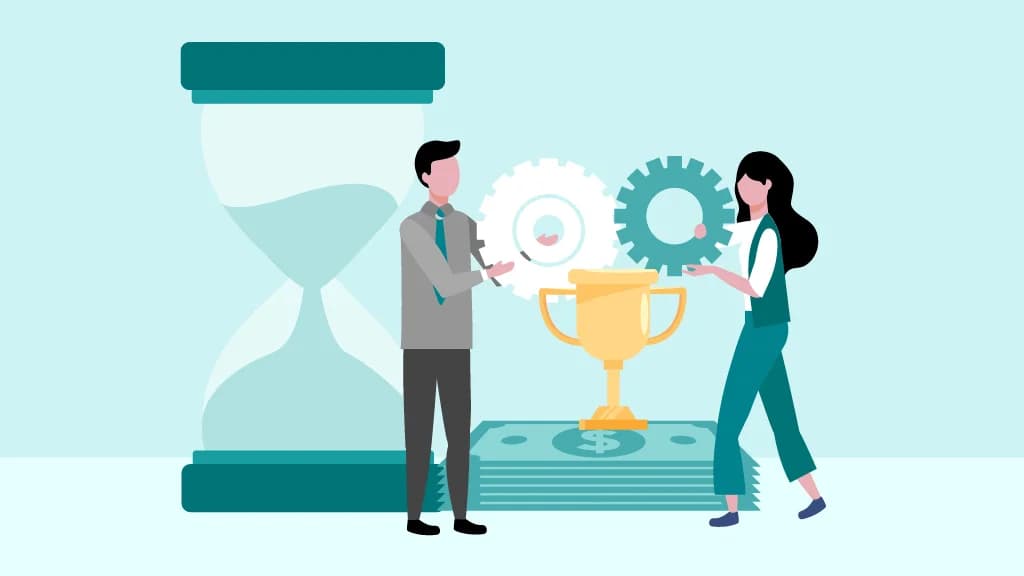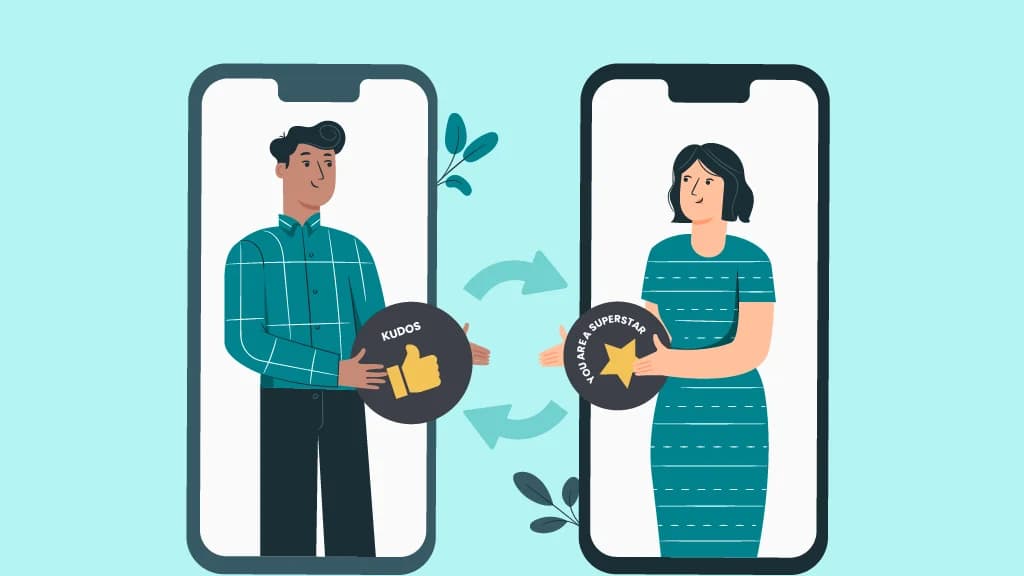10 Examples & Benefits of Extrinsic Rewards For Employees

Team AdvantageClub.ai
September 25, 2025

In challenging business environments, employees must be inspired to instill a positive workplace culture. Extrinsic rewards are among the most effective ways to increase workplace motivation. These rewards are tangible assets given to employees for their efforts, performance, and productivity. While going for financial incentives or using other material things, extrinsic rewards place the employees in a position where they are valued, and, therefore, they will work harder.
Effective extrinsic rewards are crucial in modern workplaces since reimbursement does not suffice for employees. These rewards meet desires for recognition, promotion, and work-life balance. When used correctly, they help to build consumer interest, increase loyalty, and guarantee that the company obtains the desired results. This article discusses ten effective strategies of extrinsic rewards for employees and the numerous values that they bring to the company. We’ll also highlight some of the most practical extrinsic rewards examples workplace leaders can adopt to boost motivation.
What Are Extrinsic Rewards?
An extrinsic reward is a physical and visible reward given to an individual or employee for attaining a goal. They generally have a monetary value, such as a pay rise, bonus, award, or public recognition. Extrinsic rewards emphasize real, external incentives that validate and recognize an employee’s accomplishments.
Intrinsic rewards include increased job satisfaction, promotion, recognition, gift cards, bonuses, salary increments, and paid vacations. The main difference between intrinsic and extrinsic rewards is the sources of satisfaction: intrinsic rewards are achieved from within, while extrinsic rewards are incentives issued by the employer.
Extrinsic rewards can also attract and motivate employees to become part of a family within the organization. It creates an atmosphere of trust and belonging, and employees who are told their efforts are appreciated and will be rewarded are encouraged to set out on more endeavoring tasks that lead to excellence. Such incentives value the employees’ hard work and contribute to a workplace culture of supportiveness and encouragement. Let’s dive into the benefits and examples of how extrinsic rewards may impact your workforce.
10 Real-World Examples of Extrinsic Rewards
Now that we’ve explored the benefits of extrinsic rewards, let’s look at ten practical extrinsic rewards examples workplace organizations can apply.
1. Bonuses for Achieving Sales Targets
The most common extrinsic reward is related to increased sales performance. Financial incentives include a cash bonus for selling above the sales quotas. These benefits provide an evident relationship between the employee and the reward, motivating sales teams to reach and exceed their goals.
To encourage more of the same in the future, a sales team that meets or surpasses their quarterly goal, for example, is given a sizable bonus. Advantage Incentive Automation is aligned to generate sales contests with minimal effort to motivate sales employees in a gamified environment.
2. Gift Cards and Vouchers
Gift cards are the most preferred extrinsic reward since they allow the employee to utilize his/her reward on what he/she considers best. As the choice is always based on the holder’s preferences, it does not matter whether it is a restaurant, a store, or an Internet store; the gift cards will be more effective.
Advantage Marketplace can simplify the process by allowing organizations to curate personalized rewards, such as e-gift cards and more, for various occasions from the 10,000+ brands available. This enhances employee satisfaction and motivates them to achieve more.
3. Recognition Programs
Public recognition is good for rewarding employees. A certificate, a plaque, or being publicly appreciated at team meetings strongly motivates employees. Rewarding an employee in front of other employees makes him or her feel appreciated within the workplace. For instance, when an employee is awarded during a group meeting, it increases their morale, and they’ll feel an important part of the business.
With programs such as Advantage Recognition, technology and AI enhance the recognition process, enabling organizations to reward employees without much delay or prejudice.
4. Spot Award
Spot awards are a great way to recognize superior performance from employees immediately. Organizations can digitize the entire rewarding process, from allocating budgets to redeeming rewards in real-time, making appreciation both seamless and impactful with solutions such as Advantage Recognition.
To encourage the development of team spirit, Advantage Communities provides for inclusion through the union of like-minded people to form a sense of belonging within the workforce. In addition, Advantage Marketplace allows for the issuance of personalized vouchers and gifts to make every spot award memorable and meaningful.
Pairing recognition with employee wellness? Leverage Advantage Wellness, a holistic platform that integrates fitness challenges, health tracking, and gamification, further enriching the rewarding experience.
With these innovative tools, companies can ensure that spot awards are not only prompt but also highly engaging and tailored to the needs of their workforce.
5. Healthcare Benefits
Better healthcare or wellness allowances are essential extrinsic rewards illustrating a company’s concern for enhancing employee fitness. Having health insurance plans or wellness programs shows that the employer worries about the employees’ overall health. This extrinsic compensation improves job satisfaction and retention by creating a healthier, more productive workforce.
6. Promotions and Raises
Career advancement is the most influential extrinsic reward for encouraging employees. One can take an employee from a lower rank and post him to a higher rank or improve his performance-based remuneration. The desire for career advancement and better returns motivates employees to remain with the organization and produce fruitful performances.
For example, suppose an employee has been demonstrating excellent performance in his job responsibilities. In that case, they may be promoted to manager or given a salary increase that rewards them for their efforts. This generates a sense of loyalty and motivates ongoing effort.
7. Paid Time Off (PTO)
An extrinsic compensation system allows companies to give their hard-working employees more paid time off. An example of extrinsic rewards is that an employee loyal to the company and performing very well might be rewarded with an extra week’s leave.
This demonstrates gratitude and a good relationship between personal and professional time; hence, the worker is fired up to continue contributing impressive work once they are back.
8. Team Outings or Celebrations
Group rewards like take-outs or dinners are best for the entire team. These rewards focus on a team or department’s achievement, enhancing camaraderie and boosting overall organizational morale. For instance, taking a group on a fun trip or organizing a party to celebrate after accomplishing a significant task boosts morale and encourages further collaboration. These group activities form great memories that connect the employees to colleagues and the company.
9. Professional Development Opportunities
Supporting a worker’s professional growth is a powerful extrinsic reward. Co-sponsoring courses or certifications rewards employees for their hard work and helps them grow. For example, an employee who performs excellently may be taken through leadership skills or a professional course of his specialty. One-of-a-kind motivation motivates employees since it signifies a financial commitment on the part of the organization to educate the staff, hence continuously fostering long-term loyalty.
10. Free Meals or Office Perks
Offering everyday office amenities such as coffee, food, or meals benefits the company and shows employees they are cared for. For instance, candidates are motivated when the employer provides them lunch after completing a challenging assignment.
These small perks enhance the workday and increase employee satisfaction, leading to higher productivity and engagement.
Industry-Specific Examples of Extrinsic Rewards
Extrinsic rewards aren’t one-size-fits-all; the following extrinsic rewards examples workplace show how they adapt across industries. Here’s how:
-
Tech Industry:
A global software company uses spot recognition gift cards to reward developers who solve high-priority bugs under pressure. The instant recognition drives innovation and speeds up product delivery.
-
Healthcare:
Hospitals often use performance rewards like extra PTO or wellness allowances for nurses who maintain excellent patient satisfaction scores. These extrinsic rewards boost morale in high-stress environments.
-
Retail:
Store associates hitting monthly sales goals often receive gift card incentives or performance bonuses. This approach reduces turnover and drives frontline engagement.
-
Manufacturing:
Safety-based rewards, such as cash bonuses or team outings for zero-incident months, encourage compliance and create safer work environments. -
Education:
Schools and universities may offer professional development stipends or recognition awards for teachers achieving high student performance outcomes.
Each example shows how extrinsic rewards can be tailored to match the unique pressures and performance measures of a given industry.
Benefits of Extrinsic Rewards in the Workplace
Extrinsic rewards are more than just tokens of appreciation. They offer significant advantages that can boost employee performance and satisfaction. Below are the primary benefits of extrinsic rewards in the workplace:
1. Motivation Boost
Offering extrinsic rewards can significantly boost motivation. For example, employees will work toward the goals, expecting to be praised or receive bonuses for the achievement. A study based on various research and studies from the Harvard Business Review shows that employees receiving tangible rewards are up to 15-22 percent more efficient than their fellow employees. It is a way to achieve higher engagement and overall productivity.
Employee success is primarily dependent on workplace motivation. Whether it’s individual achievement or team collaboration, the lure of extrinsic rewards can be a great motivator that can be relied on in the long run. With these rewards, employees are motivated to challenge themselves and achieve a high-performance culture.
2. Performance Improvement
Specific and reward-interest-oriented goals help motivate individuals, especially employees. Extrinsic rewards reinforce performance, creating a results-oriented work culture. Positive reinforcement, whether in the form of a team delivering on time or an individual arriving with answers, leads to higher productivity throughout the organization.
Extrinsic rewards proved effective in helping organizations establish goals and expectations, create conditions to promote positivity and obtain constant enhancements in productivity and performance. McKinsey & Company’s research has shown that effective and well-structured reward systems improve worker performance by 20% in the long run.
3. Employee Retention and Satisfaction
Employees who feel appreciated by their employer are less likely to depart. Rewarding on the job increases job satisfaction and reduces the turnover rate. According to the Employee Benefit Research Institute, 63 percent of employees who are happy with their incentive programs will likely stay with their employers. A well-designed incentives system will go a long way towards reducing staff turnover and costs.
One key goal of any compensation scheme is staff retention. Employees who are motivated through incentives feel appreciated and have a sense of ownership of the work accomplished. Such an emotional attachment results in customer loyalty, which keeps them in the company for a long time. Extrinsic incentives can be more easily assigned to solve need-related concerns, increasing retention.
4. Encouragement of Desired Behaviors
Companies can change employee behavior to meet overall company objectives by connecting rewards with particular organizational goals. An example of extrinsic rewards promotes cooperation and encourages candidates to join in task completion. Still, extrinsic rewards promoting idea production will push candidates to explore new issue-solving methods. Extrinsic incentives encourage behaviors that align with the company’s goals, fostering a culture of collaboration, creativity, and proactive problem-solving.
This helps align the individual’s performance with achieving its intended goals and motivates the employee to work harder to achieve the company’s goals. As a result, when an employee understands that their input is linked to the business’s performance, they will participate in activities likely to provide the desired good end.
Implementation Timeline / Checklist: How to Effectively Implement Extrinsic Rewards
Step 1 – Assess Employee Needs (Month 1):
Listen to employees through surveys, focus groups, or quick check-ins to learn what motivates them, cash bonuses, employee recognition gift cards, or extra time off. Matching employee incentives to real preferences builds stronger workplace motivation and prevents rewards from feeling generic.
Step 2 – Define Goals (Month 1–2):
Link extrinsic rewards directly to business objectives like boosting sales, reducing turnover, or driving innovation. Setting clear objectives facilitates measuring performance incentives and proving the program’s worth.
Step 3 – Design Reward Framework (Month 2):
Offer a balanced mix, performance bonuses, gift card incentive programs, PTO, or recognition awards. Be transparent about eligibility and criteria so employees see a fair connection between effort and reward.
Step 4 – Pilot Program (Month 3–4):
Start small by testing the program in one team or department to see how employees respond. Gather feedback and track performance results to refine the design before scaling.
Step 5 – Rollout (Month 5):
After refining, expand the program company-wide with clear communication about its purpose. Share examples of extrinsic rewards in action to help employees connect with the program.
Step 6 – Measure ROI (Month 6+):
Track KPIs like performance improvements, retention rates, engagement scores, and satisfaction levels. Use these insights to demonstrate how employee rewards gift cards and recognition programs deliver business value.
Step 7 – Adjust (Ongoing):
Keep rewards relevant by updating options and listening to feedback regularly. Flexible extrinsic rewards ensure long-term workplace motivation and stronger performance rewards.
How to Effectively Implement Extrinsic Rewards
To maximize the impact of extrinsic rewards, organizations must implement them thoughtfully and strategically:
-
Identify the Right Reward Type:
The key insight here is identifying employee preferences. A few may want monetary rewards, while others can opt for intangible incentives such as promotions or the opportunity to be trained in a newly learned skill.
-
Align Rewards with Organizational Goals:
This practice must be connected to the company's goals and objectives so that employees' efforts directly impact the company's outcomes. For example, Rewarding customer service excellence is aligned with a company's aim of increasing customer happiness.
-
Be Consistent:
Ensure that awards are distributed fairly and consistently. You work towards that objective daily, but the message to employees must be clear: effort will be rewarded if expectations are fulfilled or exceeded.
-
Foster a Balanced Approach:
While extrinsic rewards are essential, they should not replace intrinsic motivation. Combining external rewards with intrinsic satisfaction leads to a more engaged and motivated workforce.
Common Challenges of Extrinsic Rewards
Extrinsic rewards motivate performance, but they present a list of problems that affect workplace culture. Here are some potential pitfalls to be aware of:
-
Fostering Unhealthy Competition:
Awards based on competition can promote a harsh environment. This may hinder candidates' interaction and work on group projects required for the company's productivity.
-
Risk of Reducing Intrinsic Motivation:
Most employees are motivated through their extrinsic rewards. They start to forget their intrinsic motivation, such as attaining proficiency or enjoying their work. Eventually, this results in a decrease in overall engagement.
-
Budget Constraints:
Not all organizations and companies can afford a high and very flexible reward budget. Smaller organizations confront the primary issue of raising the funds necessary to implement meaningful and regular remuneration.
Extrinsic Rewards vs. Intrinsic Motivation
Comparison Table
Feature | Intrinsic Rewards | Extrinsic Rewards |
Definition | Internal satisfaction gained from doing the work | Tangible incentives given by employers |
Examples | Personal growth, pride, purpose | Bonuses, gift cards, promotions, paid vacations |
Source of Motivation | From within the individual | From external recognition or material incentives |
Timeframe | Long-term, sustained by passion and values | Short-to-medium term, driven by specific goals |
Best Use Case | Building deep engagement and loyalty | Driving performance, achieving short-term goals |
Implementation Cost | Low | Medium to High (depending on type of reward) |
ROI Timeline | Indirect, long-term culture building | Direct, measurable within 3–12 months |
It is critical to strike a precise balance between which extrinsic rewards are appropriate to supply to promote the long-term sustainability of intrinsic motivation. Extrinsic incentives can improve short-term performance, but inherent motivation, driven by personal happiness and progress, is critical for long-term engagement.
Understanding when to use extrinsic rewards and when to cultivate inner motivations is critical. Companies that strike this balance can keep their employees motivated, engaged, and functioning at their peak.
Extrinsic rewards are an effective way to motivate employees, improve performance, and promote job satisfaction. When incentives are valuable, pertinent, and aligned to organizational objectives, companies can create a motivated and committed workforce. However, the best approach should be to offer these rewards since excessive use of extrinsic rewards is counterproductive to the continuous use of intrinsic rewards for increased employee engagement.
Employee Incentives are more than just a source of other physical rewards; they may also reflect a company’s goodwill regarding its employees’ well-being, motivation, and performance. Employee rewards programs can go a long way in enhancing job contentment, reducing turnover, and improving company culture, benefiting both the employee and the organization in the long run.
FAQs
Q. What is an example of extrinsic reward?
A common example of an extrinsic reward is a cash bonus for surpassing quarterly sales goals. Other performance rewards include employee recognition gift cards, public awards, and paid vacations.
Q. What is the extrinsic reward definition?
Extrinsic rewards are external motivators employers provide to recognize performance, effort, or results. Unlike intrinsic motivation, they come in tangible forms like bonuses, promotions, or workplace perks.
Q. What are the best extrinsic rewards examples for the workplace?
The best extrinsic rewards examples include performance rewards and bonuses, employee incentive gift card programs, team outings, promotions, and extra paid time off. These employee incentives motivate effort and strengthen workplace loyalty.
Q. Why are extrinsic rewards important in modern workplaces?
Extrinsic rewards are important because they go beyond salary to provide meaningful recognition. They motivate employees, retain top talent, and align performance with organizational goals.





